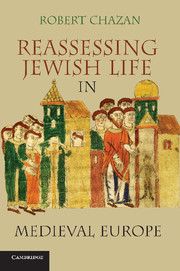Introduction: The Emergence of Medieval European Jewry
Published online by Cambridge University Press: 05 June 2012
Summary
In the year 1000, the areas of europe loyal to the roman Church were limited in size and population and were backward in economic achievement, military strength, political stability, and cultural creativity. They constituted the least of the three Western religio-political power blocs at the time, far inferior to the largest and strongest power bloc – the far-flung Islamic world – and considerably inferior to the Greek Orthodox Byzantine Empire. Some of the richest areas of southern Europe on the Iberian and Italian peninsulas were under the control of Islamic rulers, and additional areas of Italy were governed by the Byzantines. Northern Europe remained mired in its historic backwardness.
These weak sectors of Europe endured incursions from every direction by powerful external enemies. From the south, they faced constant danger from the Muslim forces that controlled North Africa and the Mediterranean Sea; from the east, they encountered the pressure of their Greek Orthodox rivals; from the west and the north, they suffered devastating raids by the seagoing Norsemen, who regularly wreaked havoc all across the northwestern coast of the continent. In a vicious cycle, the weakness of western Christendom opened it to these incessant pressures and dangers, while the external threats and incursions contributed to the ongoing weakness and backwardness. Only the most optimistic could have dreamed of better days to come, of a period when Latin Christendom might equal its more powerful neighbors or perhaps even surpass them.
- Type
- Chapter
- Information
- Reassessing Jewish Life in Medieval Europe , pp. 1 - 16Publisher: Cambridge University PressPrint publication year: 2010



